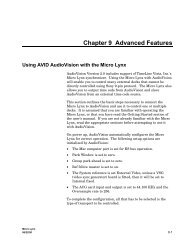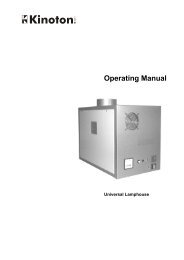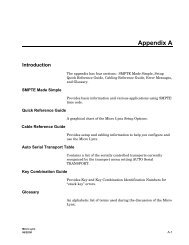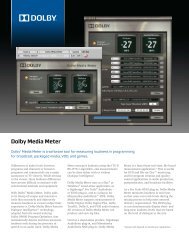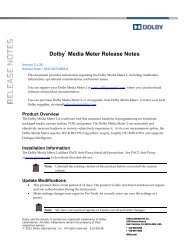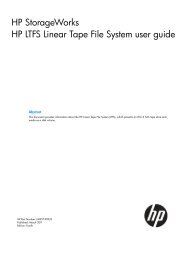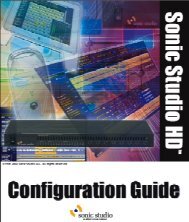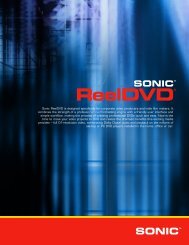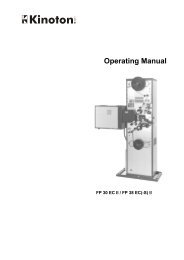Dolby LM100 Broadcast Loudness Meter User's Manual
Dolby LM100 Broadcast Loudness Meter User's Manual
Dolby LM100 Broadcast Loudness Meter User's Manual
You also want an ePaper? Increase the reach of your titles
YUMPU automatically turns print PDFs into web optimized ePapers that Google loves.
Chapter 5<br />
Features<br />
This chapter focuses on the unit’s primary functions, and the best uses for each of them.<br />
5.1 Measuring Equivalent <strong>Loudness</strong><br />
The <strong>Dolby</strong> ® <strong>LM100</strong> <strong>Broadcast</strong> <strong>Loudness</strong> <strong>Meter</strong> initially employed a standardized<br />
measurement method called Leq(A) coupled with <strong>Dolby</strong> Dialogue Intelligence <br />
technology, which allowed the <strong>LM100</strong> to automatically measure only the dialogue portions<br />
of the programming. Combined, these methods were used to accurately determine the<br />
dialogue normalization metadata value for <strong>Dolby</strong> Digital, <strong>Dolby</strong> Digital Plus, and <strong>Dolby</strong> E<br />
broadcast content.<br />
The updated <strong>LM100</strong> can now use the EBU R128 measurement algorithm, as well as ITU‐R<br />
BS.1770‐1 and BS.1770‐2. Both ITU‐R algorithms estimate loudness by computing the<br />
frequency weighted energy average over time similar to Leq(A), and each algorithm<br />
produces a single value representing the overall loudness level. The core ITU‐R algorithm<br />
of both BS.1770‐1 and BS.1770‐2, however, is based on two filters in cascade: a prefilter (a<br />
high‐frequency shelving‐type filter), followed by Leq(RLB), a revised low B‐weighting<br />
filter (a type of highpass filter). The EBU R128 and ITU BS.1770‐2 loudness measurements<br />
use a loudness gating method to better estimate the perceived loudness of the signal. The<br />
gating function is driven by a 400 ms moving average, updated every 100 ms to provide a<br />
75% overlap between successive gating blocks. The loudness is then estimated using a –70<br />
dBFS absolute gate and a –10 dB relative gate threshold. The short‐term loudness<br />
measurement is ungated.<br />
The updated <strong>LM100</strong> now has the ability to compute the <strong>Loudness</strong> Range (LRA) in<br />
accordance with EBU Tech 3342 and ITU Draft Revision to Recommendation ITU‐R<br />
BS.1770, Annex 3. The LRA measurement is a front‐end three‐second moving average,<br />
updated every 500 ms to provide an 83% overlap between successive LRA blocks. While<br />
the minimum specified overlap is 66%, an overlap of 83% was selected for alignment with<br />
the <strong>Loudness</strong> Range implementation in other <strong>Dolby</strong> products. The LRA measurement is<br />
then estimated using a –70 dBFS absolute loudness gate and a –20 dB relative gate<br />
threshold.<br />
5.1.1 Effects of Choosing the EBU R128 Measurement Type<br />
Selecting the EBU R128 measurement type has several automatic effects:<br />
• Dialogue Intelligence is locked off.<br />
• The measurement method is set to infinite.<br />
• Channel Select is locked to All.<br />
• The digital loudness reference value is locked to –23 LUFS.<br />
• The short‐term window length is locked to three seconds.<br />
• The meter scale is set to Absolute.<br />
• <strong>Loudness</strong> measurements are displayed in LUFS.<br />
<strong>Dolby</strong> ® <strong>LM100</strong> <strong>Broadcast</strong> <strong>Loudness</strong> <strong>Meter</strong> User’s <strong>Manual</strong> 39




